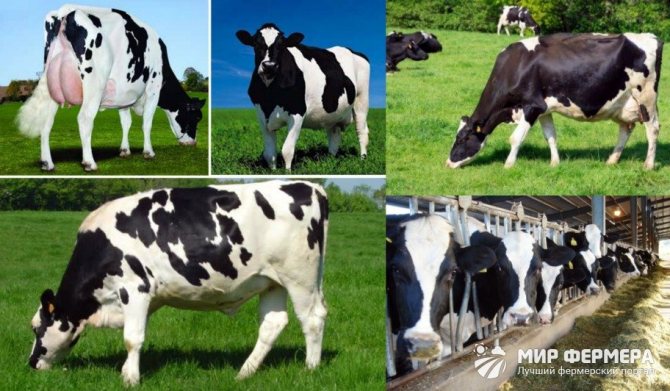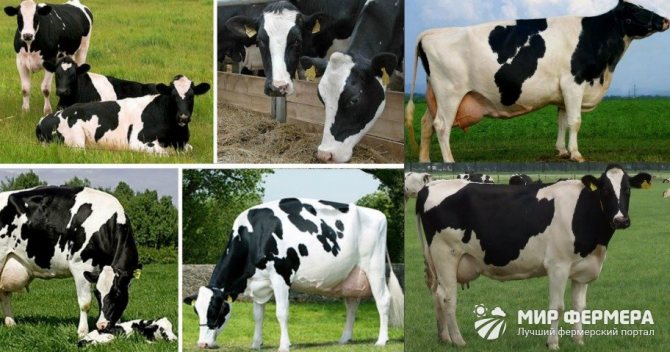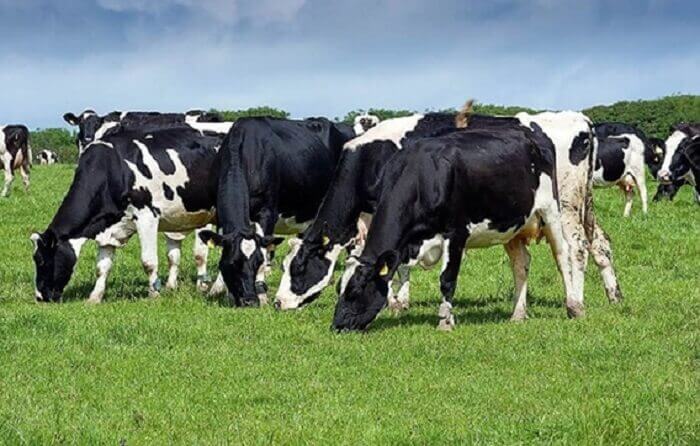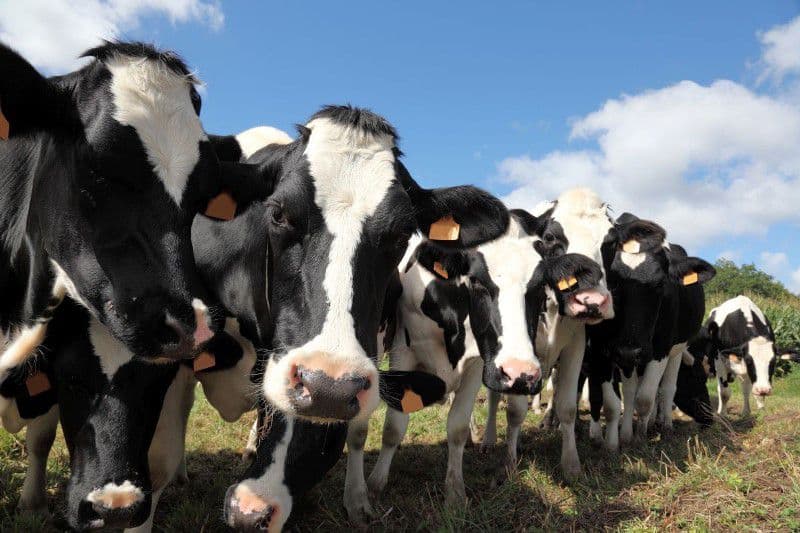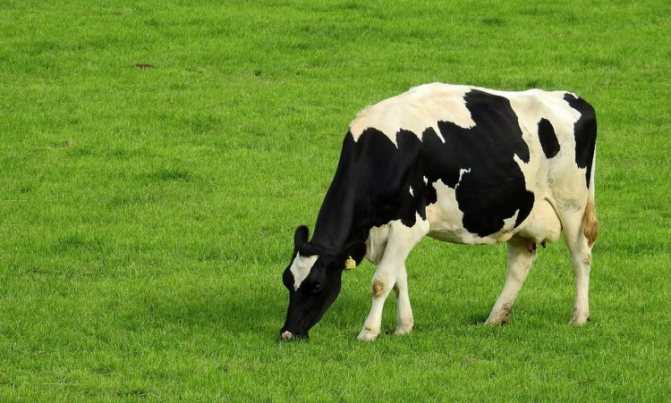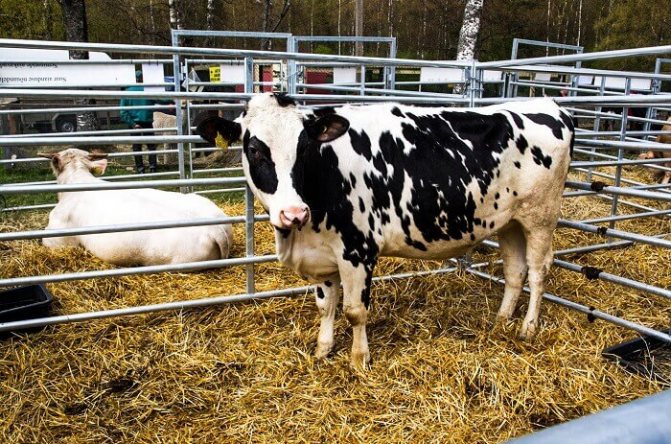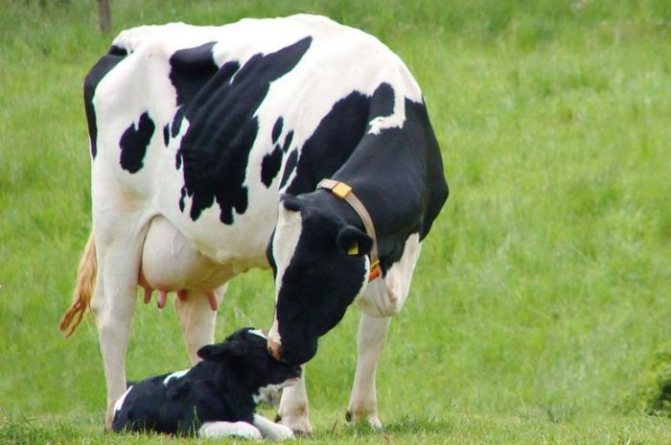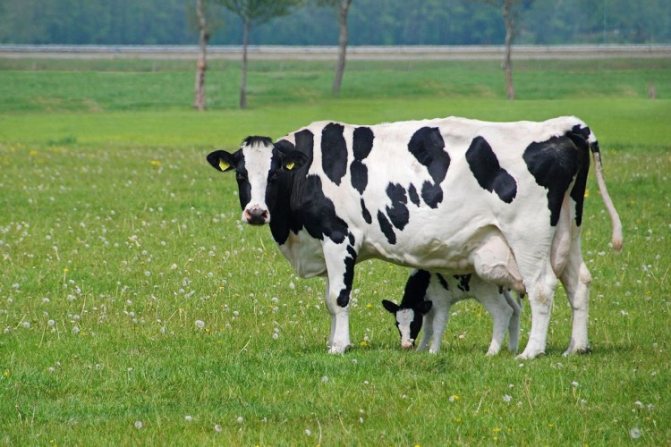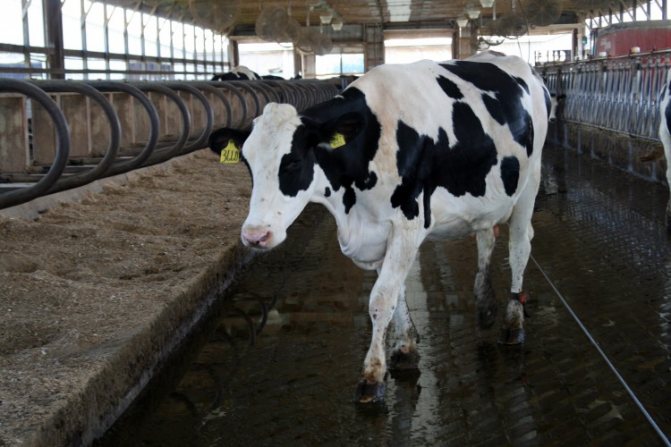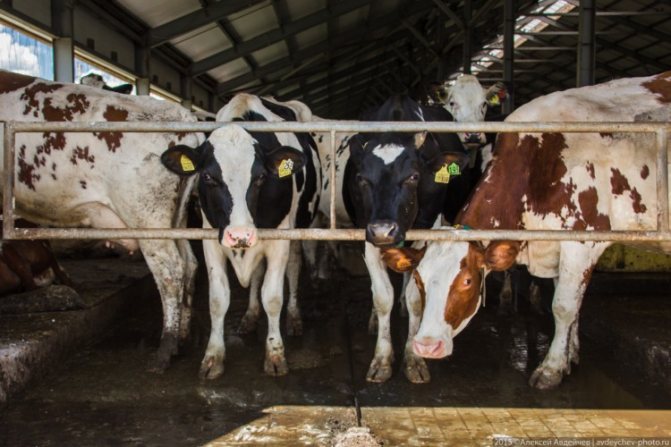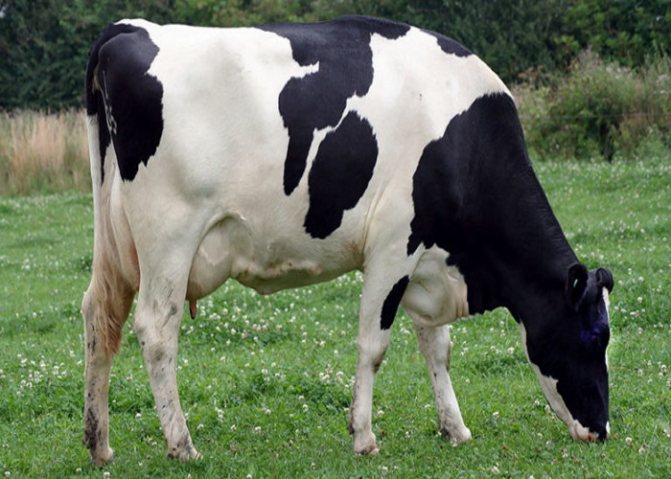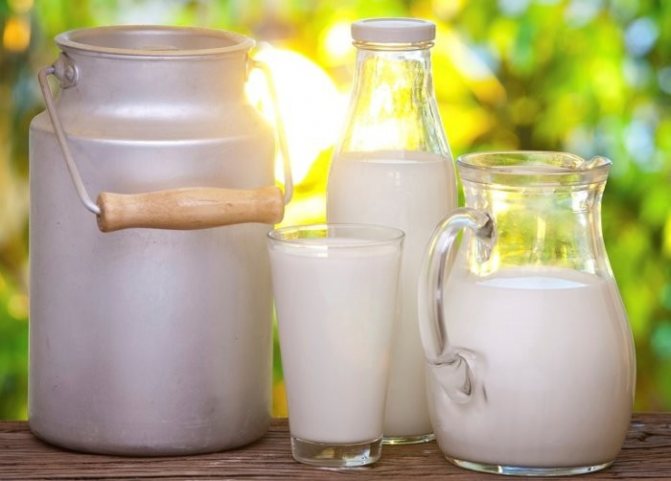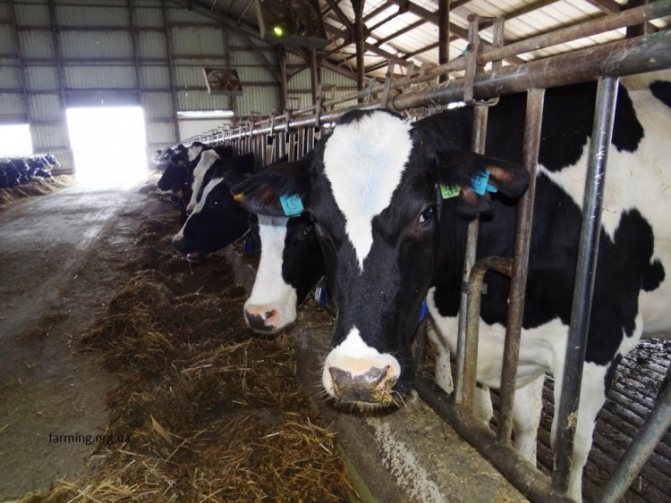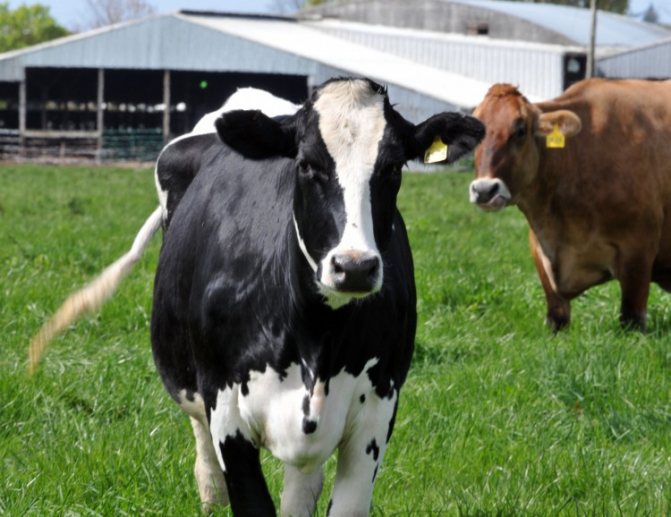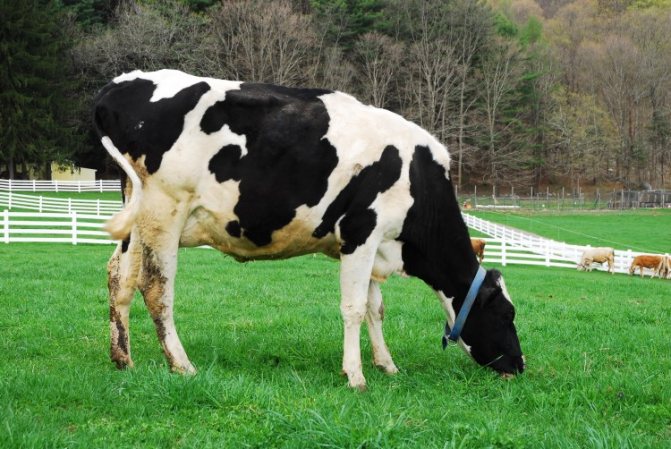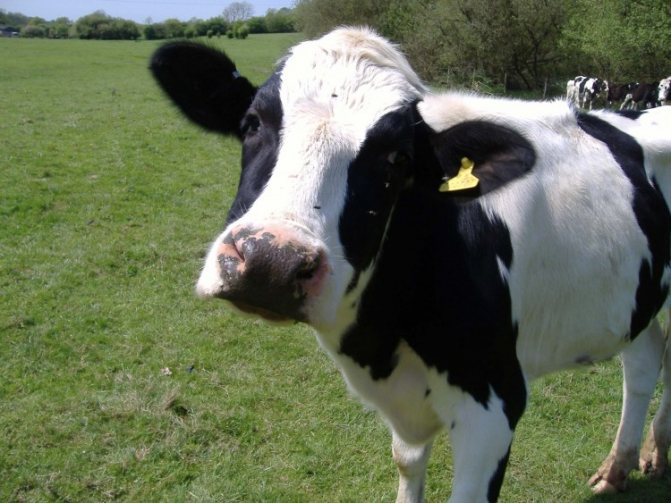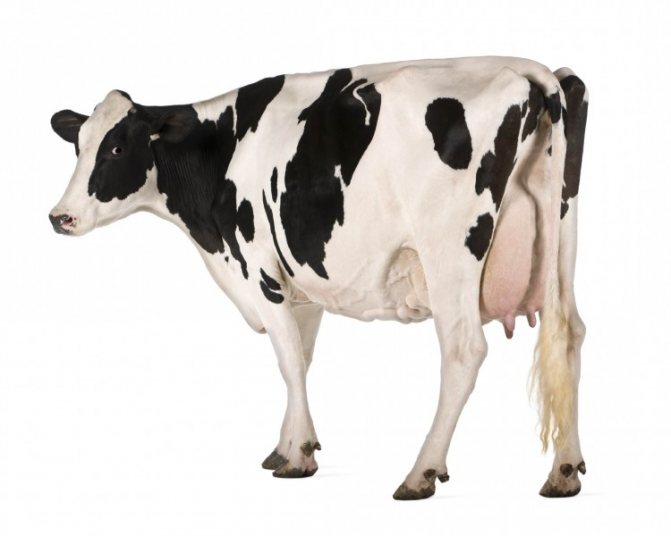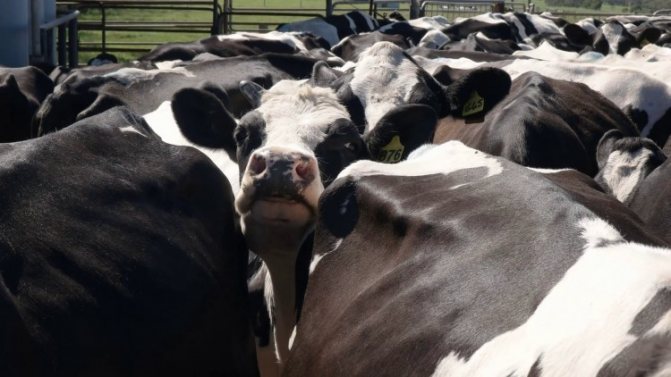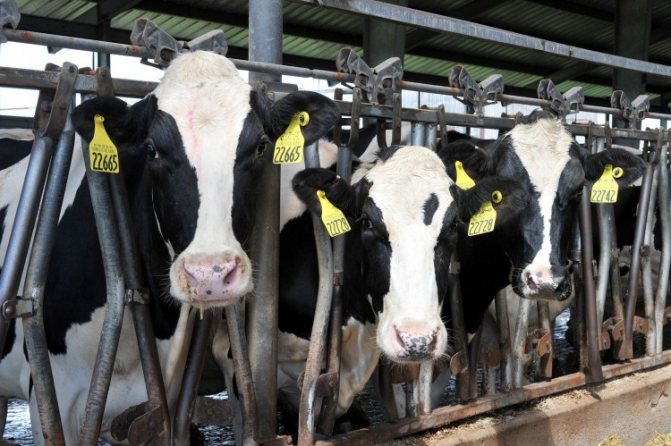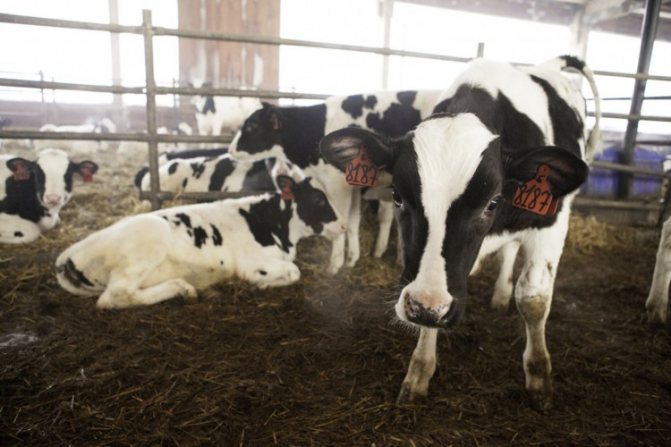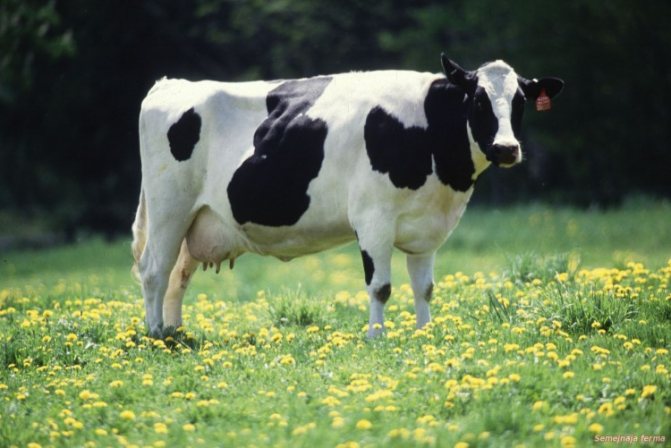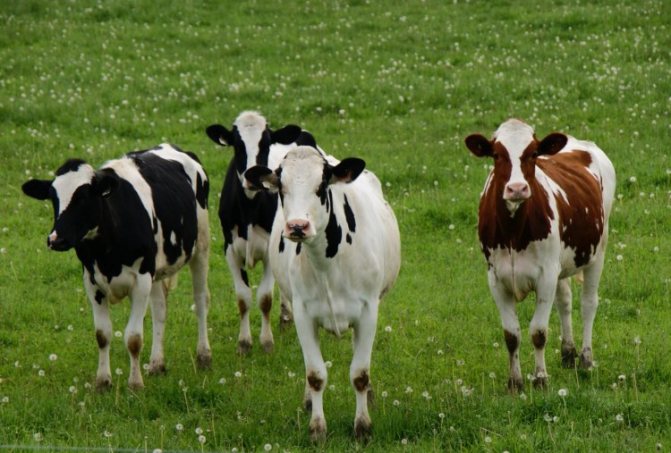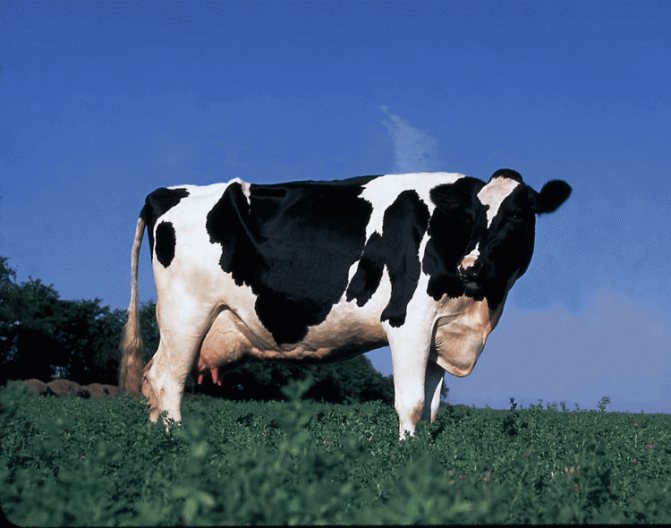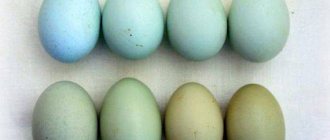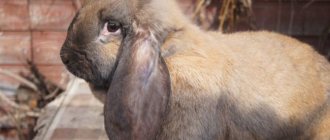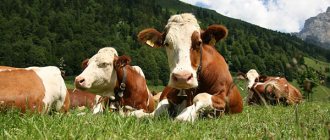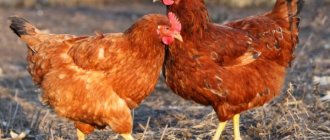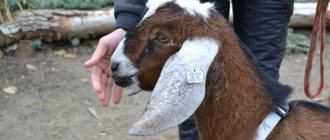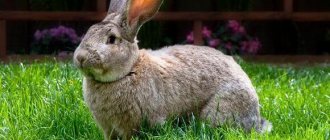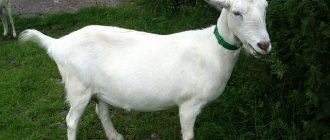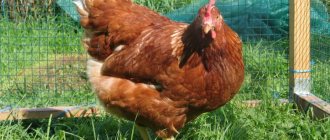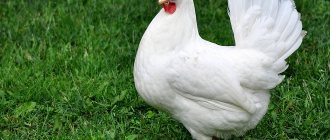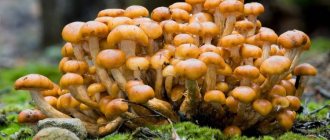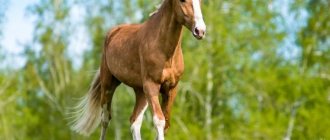The history of the appearance of the Holstein breed
This wonderful breed has an interesting history. It happens from Dutch black and white cowsimported to USA even at the beginning of the century before last. The first such cow was bought by an American farmer V. Chenery in 1852 in the Netherlands.
He assessed the productivity of the breed, and as a result of many years of breeding work, he brought out a new, more promising one. Initially she is was called the Holstein-Frisianbut in the early 1980s. got the name Holstein.
The animals were distinguished by high milk yield and excellent quality of the milk received.... Holstein Friesians are still used in breeding for crossing with other, less promising dairy breeds.
Cows appearance
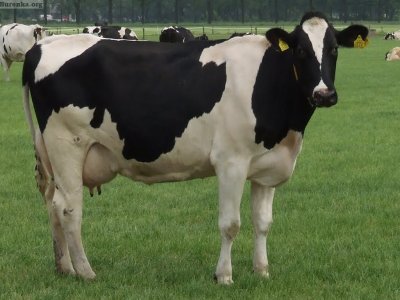
The main distinguishing feature of the Holsteins is coloration... She is necessarily white, with large black spots.
There are individuals of pure black color, but small white markings are always present on the legs and tail. Distinctive features:
- large, high-set, bowl-shaped udder;
- chest depth 80-87 cm, width 65 cm;
- wide, strong back;
- long, well-developed shoulders;
- back part up to 63 cm;
- the body is large, wedge-shaped.
The main feature of the species is considered to be very high productivity and large udder size.
Characteristics
Holstein - the dairy cow in the world... Milk yield and fat content depend on the conditions of keeping and nutrition. For example, in Israel from one individual it is possible to obtain about 10 tons of milk per year, from fat content no more than 3%... IN America these indicators are slightly different: 8 tons per yearbut fat content more than 3.5%.
During the day one cow is able to give more than 70 kg of milk... FROMmilk flow rate when milking, about 2.5 kg / min.
Adult weight may vary from 600 (heifers) to 1000 kg (bulls)... With enhanced nutrition, these indicators can be increased to 900 and 1300 kg, respectively. Height at the withers of a cow is about 145 cm, and the goby - more than 1.5 m.
Newborn calves weigh on average 35-45 kg... Heifers grow and gain weight very quickly. By the year they have weight 250-300 kg, which is not typical for a dairy species. But their meat productivity is rather low, no more than 60%.
Photo of the "Holstein" breed of cows:
Milk productivity
Milk yield of Holstein cows depends on several factors. If you do not take into account the conditions of detention and the quality of food, then the color of the wool largely affects the milk production. Red-and-white cows rarely give the same milk yield as black-and-white ones.
The average milk production of blacks is 7.3 thousand kg per year, the fat content does not exceed 3.8%. Red - rarely give more than 4.5 thousand milk per year, fat content 4%. These figures were obtained from Russian farmers. In other countries, they differ slightly.
At home, annual milk yields vary from 5.5 to 6 thousand kg.
The Holstein cow is equally well suited for hand milking and machine milking.
Nutrition and care
Holstein cows are very picky and demanding in terms of nutrition and maintenance. In the conditions of Siberia, the northern regions of Russia, they hardly take root. They are require special hygiene standards and temperature indicators, need regular cleaning and cleaning of the stall, bathing and fresh bedding.
In farms, they are kept mainly in a loose way. If these requirements are not met, a decrease in immunity is observed in animals.... They can be exposed to infectious diseases.
With any deviation from the usual conditions, milk yield and weight of the animal decrease. These cows need an enhanced, balanced and varied diet.
In winter in their diet must certainly be present corn, legumes, protein-rich meal, vitamins and minerals, root crops, silage, high-quality hay. In summer need to provide food fresh grass and compound feed.
Fattening
The breed is distinguished by its fastidiousness in food and living conditions. In the cold regions of Russia, Holsteins practically do not take root.
This is mainly the northern part of the country and Siberia.
In large farms, cows are not tied down. Stalls are cleaned regularly and bedding is changed frequently.
The availability of water and balanced feed is constantly monitored. In the summer, fresh grass is harvested for the animals, feed is given. In the cold season, the diet includes corn, root crops, silage, legumes, high-quality hay, and protein-rich meal.
To maintain immunity, a mineral complex and vitamins are added to the feed.
fermeru.site
Diseases
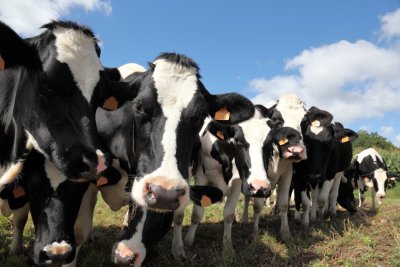

Holstein cows are distinguished by excellent health... They are very energetic, and they can get sick only if the rules of maintenance are not followed.
If a not paying enough attention to cleanliness and hygienethen the animal may be exposed to infectious diseases, for example, necrobacteriosis or leptospirosis.
Treatment is carried out after a veterinary examination, by intramuscular injection antibiotics.
Unfortunately, the life expectancy of cows is extremely short... As a rule, they can withstand no more than 3 calving.
Breeding rules
In the breeding of the breed, high-quality sire bulls play a primary role. Often they are used for crossing with representatives of other breeds in order to increase productivity. Dilution for milk production is quite beneficial, but only if the content is correct.
In breeding and growing Holstein, it is important to provide not only complete, enhanced nutrition, but also strictly adhere to the content rules... When choosing a cow, it should be borne in mind that this in itself is quite expensive breed... In addition, it requires a lot of money for feeding and maintenance. Pays for itself Holstein cow only in case of proper care.
conclusions
- Holstein cows are a highly productive dairy breed, developed in the late nineteenth century in the United States.
- Animals of this species are large: heifers reach a weight of 700 kilograms, gobies - 900 kilograms.
- The breed gives high yields - up to 8000 kilograms of product with a fat content of 3.2% per year.
- Holstein cows are whimsical to living conditions. They require careful maintenance, insulated sheds, feeding exclusively with first-class feed, regular monitoring by a veterinarian. Otherwise, their productivity is significantly reduced.
- Heifers of this species give offspring 2-3 times a year. It is recommended to bring them together only with representatives of their own species in order to avoid defects and mutations in the offspring.
- With proper care, this type of cow is resistant to various diseases.
Competent care, complete and balanced feeding and proper maintenance for cows of this breed are the key to high milk yield.
Read more:
- Kostroma breed of cows description characteristics
- Ayrshire breed of cows - characteristics and description
- A hornless cow is what a description of the breed is characteristic
- Characteristics of the Simmental cows
Useful video
Features of caring for the "Holstein" breed of cows in the video below:
If you find an error, please select a piece of text and press Ctrl + Enter.


Among the many varieties of dairy cattle, the Holstein cow is rightfully considered one of the best.It is distinguished by high milk yield, lack of special requirements for keeping conditions, average meat productivity. Thanks to these qualities, the breed line has spread widely throughout the world.
Testimonials
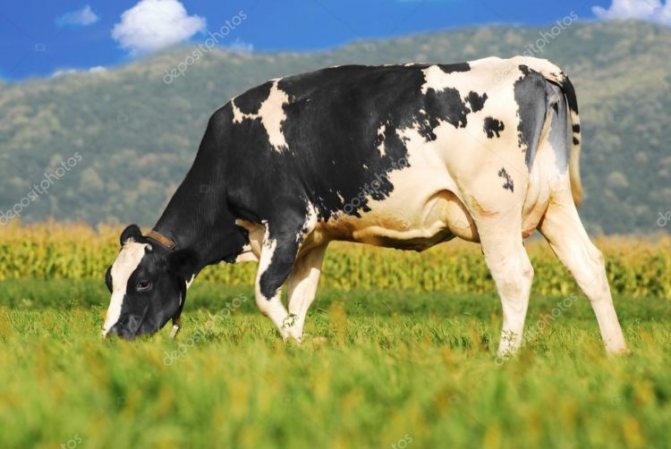

Svetlana
I didn't really like this cow. I tried to take a few, but I won't do it anymore. Despite the fact that they produce high quality milk and in large quantities, these animals are very demanding in terms of keeping conditions. They require food that contains various vitamins and minerals. In addition, these cows do not live long, which does not really suit me.
Igor
On my farm, this breed of cows is held in high esteem. Thanks to them, I sell milk very profitably, because they can produce not only high-quality dairy products, but also do it in large quantities. I feed them with hay, compound feed, fresh grass. Every day they are driven out to the pasture, where they can find their own grass on their own. They spend the night in a room that must be warm and cozy.
Ilya
When I had such a breed, I was very worried with them in terms of the fact that they often suffer from mastitis. But here there is also my fault, since there would be a draft in the barn, which is unacceptable for this breed. They are also finicky in nutrition. They want to eat only high quality food. As for productivity, there are no complaints here. The milk is delicious and abundant. Now I don't keep such cows, as they live very little.
Characteristics of the breed
The Holstein breed of cows is equally well suited for both small subsidiary farms and large cattle breeding enterprises. This animal is the result of long-term selection work, and due to a number of features it is actively used today to breed new varieties of cattle.
Origin
Several breeds of cattle from Belgium, Denmark and Holland were used in the formation of the Holstein cow. But the main breeding work was done already in the USA, where the animals were brought by settlers at the beginning of the 19th century. The imported cattle, due to the high milk yield, aroused particular interest from the local farmer Winsrop Chenery, who purchased several heads for breeding on his farm. As a result, he significantly increased the milk productivity of animals and by the second half of the century created his own breed of cows, which was named "Holstein-Friesian".
The advantages of a new breed of cattle for North America did not go unnoticed, and in 1871 an association of breeders was created, which dealt exclusively with this breed. In the same year the pedigree book of this breed line appeared.
Dignity
The high demand for such livestock in the world can be traced mainly due to a number of advantages that the breed possesses. And these moments, in addition to high milk production, also include:
- high resistance to various cattle diseases;
- quick adaptation in any climate;
- calm disposition and lack of aggression towards other inhabitants of the farm or courtyard;
- high quality beef obtained from Holstein bulls;
- early puberty in heifers.
Maintenance and breeding
Holsteins are quite sensitive to conditions of detention. Moreover, a sharp transition to new feed, temperature changes, mud in the stable are perceived by animals as severe stress and will necessarily lead to a decrease in milk yield.
When preparing a barn for keeping cows of this breed line, you should consider the following points:
- it must be dry and warm, for which it is necessary to provide high-quality insulation of the walls and ceiling;
- a functional supply and exhaust ventilation system must be present;
- drafts must be completely eliminated;
- it is required to equip drains in the floor that will help maintain cleanliness in the machines;
- it is also important to organize the correct lighting system;
- The barn should be spacious, since the high density of the cows is perceived extremely negatively by the cows and leads to a decrease in milk yield.
Important! The best option for keeping such animals is a loose box. Subject to all other conditions, it allows you to reach maximum milk yield and maintain optimal livestock health.
Also, when breeding Holstein cows, you should adhere to the following nuances:
The breed loves cleanliness.
- cleaning in the barn is carried out daily (Holsteins are extremely clean animals);
- litter is replaced as it cakes and becomes dirty;
- the cow must be provided with a sufficient amount of drinking water, which must be warmed up before serving;
- cows need constant veterinary control.
Of course, one of the most important aspects of obtaining high milk yields is proper feeding of livestock. It is best to use a high protein feed for this purpose. If feeding is carried out on the basis of compound feed and hay (greens), then it is important to ensure that a significant part of the food is made up of various legumes (alfalfa, peas, lupine).
Attention! It is imperative that you also include wheat, root crops, vegetables, mineral and vitamin supplements in the diet.
The calculation of feed volumes is carried out as follows: for every 100 kg of mass, at least 2 kg of hay and 8-10 kg of vegetables per day are needed, and the higher the productivity of the animal, the more feed is needed. The transitions between summer and winter ration or different types of food base are carried out within two weeks. If the period is shortened, this will affect the volume of milk yields.
As far as livestock breeding is concerned, cows are ready for insemination by 14 months of age. But most often it is carried out when the animal reaches the age of 24 months. Calving in Holsteins is usually easy and does not require much human intervention. Complications during childbirth are traced only in 10% of cases.
Breeding history and origin
Breeders have been breeding Holstein cows for a very long time. By the way, the work is being carried out continuously to this day. They were bred by crossing representatives of such dairy cattle breeds as Belgian, Dutch and Danish cows. At the beginning of the 19th century, cattle were brought to the territory of the United States of America, where the largest number of breeding works was carried out. Winsrop Chenery is one of the brightest representatives of breeders who made a great contribution to the development of the Holstein breed. One of his main achievements is considered to be an increase in the rate of milk yield in cattle.
By the end of the 19th century, breeders interested in breeding this breed of cows initiated the creation of a narrowly focused club. It should also be emphasized that the herd book appeared at this time.
Until the eighties of the last century, another name for cows and bulls of this breed was actively used - Holstein-Friesian.
Animals of the Holstein breed are mostly white in color, their surface is covered with black spots. Sometimes it happens to meet a red cow. Such representatives of cattle are selected for breeding new breeds.
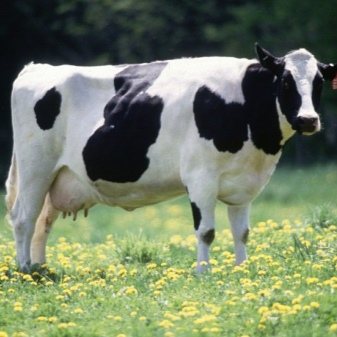

Exterior
Holstein cattle have an average body weight of 6.5-7.0 centners, sire bulls are sometimes heavier than a ton. Gobies, newborns, weigh about half a centner, and heifers are 20% less.
The chest of cows is deep and wide, the rear is long, straight and wide (in the cows the distance is 61-63 cm).
Height, at the withers, by one and a half years, in heifers 119-123 cm, by the time of covering 125-128 cm. The constitutional type of constitution is "strong". Bulls are heavier than cows and 28% taller.
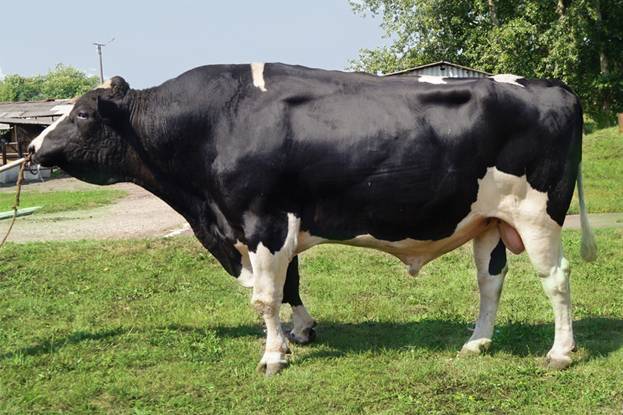

Characteristic
According to the description, the Holstein cattle species is quite large.
- The weight of bulls of this breed can reach 1200 kilograms, and the weight of heifers can vary from 650 to 750 kilograms.
- The maximum height of Holstein can reach 1.6 meters. Today, continuous breeding work is underway aimed at increasing the mass of females of this breed. This is to maximize the milk production of the animal.
- Newborn calves usually weigh less than heifers - their weight is 35 kilograms, while the same figure for heifers reaches 40 kilograms.
- It is worth emphasizing that despite the rather impressive size of the Holstein animals, their muscles are not sufficiently developed. Outwardly, this is very noticeable by the prominent ribs of the cows. Also, the body of the cattle is covered with mackerels.
- The udder of female animals is shaped like a wide bowl, which is completely covered with small white hair.
- The legs of the cow are long and the joints are very strong.
- Despite the dairy orientation of cattle, slaughter can reach good meat quality marks. It is over 50 percent.
The Holstein cow is great for any size farm and is bred everywhere. The living conditions have a significant impact on the milk yield of livestock, so they are different everywhere. On average, milk yield per year can reach 8.5 tons, while the fat content of milk will be 3.7 percent. Also, the climate has a huge influence on the milk yield. In a mild climatic zone, this figure can increase significantly.
Interestingly, representatives of the breed with a variegated color produce twice as much milk.
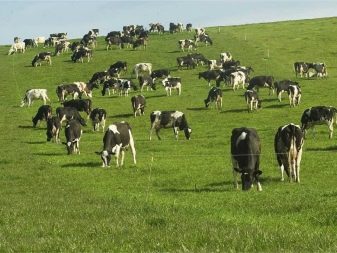

Appearance
The Holstein breed has several types suits.
- Black and motley. This color of cattle is very common. A distinctive feature of these Holsteins is their high milk yield per year.
- Red and motley. This color of the animal was influenced by a recessive gene, it is believed that it is located under the black color of cattle. Not so long ago, cows with a similar color immediately succumbed to culling. Now they are being selected for breeding new breeds. The milk yield of these representatives of cattle is much lower than that of the previous ones. But it should be emphasized that the fat content of milk in red-and-white cows is higher.
- Bluish mottled (very rare). Cows of this color look like this because of the mixture of black and red hairs. This led to the formation of a kind of gray hair, which has a bluish tint.
External characteristics of the Holstein cattle breed:
- the body is oblong and massive;
- the chest is very wide;
- voluminous udder, milk veins are very well developed;
- long back;
- wide sacrum;
- narrow neck.
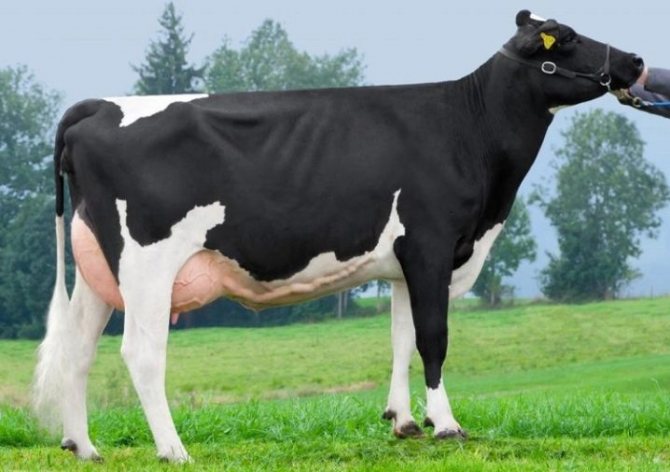

Milk productivity
A Holstein cow is capable of producing a record amount of milk per year. But to achieve these results, proper care must be provided. By the way, even the color of the coat can affect the milk yield of Holstein cattle.
If we rely on the indicators of milk yield, which were presented by Russian farmers, then the representatives of the black-and-white Holstein are the record holder. On average, such a cow gives 7,300 kilograms of milk per year. The maximum fat content can reach 3.8 percent. In red-and-white Holstein cows, the annual milk yield is much less and does not exceed 4500 kilograms of milk per year. The fat content of the product of such cows is 4 percent. The volume of milk at home can reach a maximum of 6,000 kilograms per year. The milking process is carried out both manually and with the help of a special apparatus.
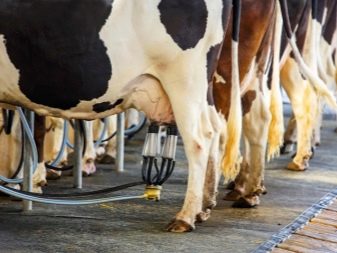

Meat productivity
The annual yield of Holstein cattle meat does not differ in high rates (no more than 55 percent), but at the same time it has excellent quality characteristics.
At 10 years old, Holstein bulls are ready to go to slaughter, their weight at this age can vary from 800 to 900 kilograms. The advantage of this breed is that they gain weight very quickly for slaughter, unlike other varieties of breeds. Therefore, Holsteins are very popular among farmers. Also another plus of Holstein cattle is early mating. They are suitable not only for crossing females of the same breed, but also for mating with other cows. This helps to significantly improve the quality of other cattle breeds.
Advantages and disadvantages of Holstein cows
We recommend reading our other articles
- Flowering shrubs
- Food for large turkeys
- How to choose a sheep clipper
- Proper feeding of pigs at home
In 1983, just in the year of registration of the species, one of the Holstein heifers gave in more than 300 days 25,000 liters of milk with a fat content of 2.8%. This is an undoubted record, confirmed by written evidence. As you can see, the breed can give a lot of milk, but what other advantages are seen behind it?
- Thanks to the excellent health, the cow very quickly digests the feed and grass that it eats, due to which it has an active increase in milk.
- Holstein cows quickly adapt to different weather conditions and climates.
- They are neat, affectionate, take care of themselves and the cleanliness of the surrounding objects: stall, feeders, drinkers, and so on. If they are not cleaned, they can either start to hurt, or the character will completely deteriorate.
- Gobies are often used for breeding other species. They are selected according to the quality and health of the previously obtained offspring (heifers, not gobies). Burenki only rarely participate in breeding.
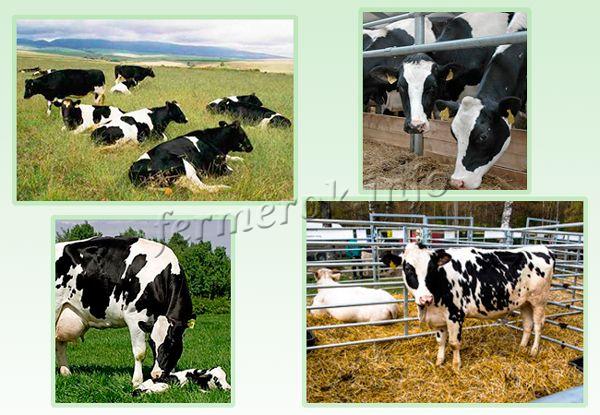

Conditions for keeping Holstein cows
Among the disadvantages are the following points.
- The rate of milk flow and milk yield of Holstein cows directly depends on the content. If conditions and care are poor, the milk supply will also decrease.
- Does not apply to economical types. They need a free stall, proper, balanced nutrition, and they eat a lot. If you are professionally engaged in dairy farming, the heifer will pay for itself, but if she holds on for herself, she will bring continuous losses.
Both summer and winter food will be costly. In winter, high quality forage, hay, additives are needed, and in summer, an abundance of grass is provided during grazing. If there is not enough grass, the indicators will fall.
- They do not differ in stress resistance. Loud sounds, sudden movements can lead to stress, and this will directly affect milk flow.
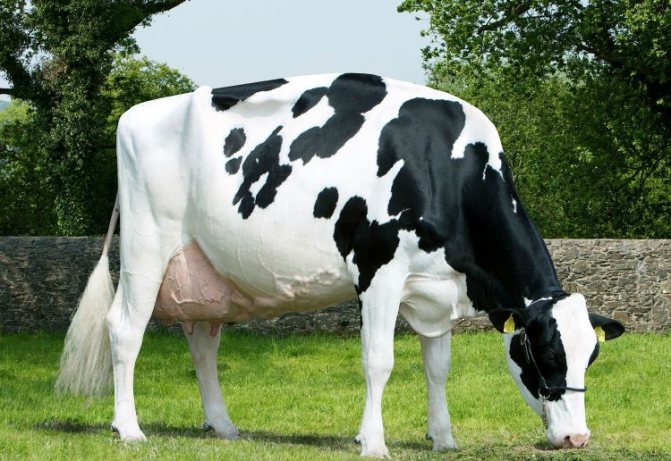

The Holstein breed has the following disadvantages:
- negative attitude to stress, entailing the loss of productivity and mass;
- exactingness to the fodder base - in the winter months it is necessary to ensure the availability of legumes and cereal hay, a number of vitamin supplements. With the onset of summer, animals will need grazing land with good grass cover;
- the need to maintain cleanliness in the room, otherwise immunity decreases;
- despite the fertility and early maturity, the slaughter weight leaves much to be desired.
Among the positive qualities are:
- high rates of milk productivity;
- animals adapt perfectly to any climatic environment;
- disease resistance if properly cared for;
- cows are clean.
The positive aspects are:
- record holders in milk yield (record, 305 days of lactation, 25 tons of milk);
- early maturity and good coverage and a small proportion of miscarriages;
- its genotype is an "improver" for other breeds of the Russian Federation;
- excellent adaptation to changing conditions of detention and weather;
- good average daily gain;
- disease resistance;
- calving of a cow is quick and requires almost no human intervention or control;
Minuses
But, besides the positive aspects, there are also disadvantages.
So, the most significant disadvantages can be considered:
- exactingness to the conditions of detention;
- hypersensitivity to stressful situations, and sudden changes in nutrition or content;
- intolerance to "cold keeping" and "keeping on a leash";
- imbalance of rations in winter and in the absence of normal conditions of maintenance leads to overspending of expensive concentrates per unit of the product obtained.
The characteristics of the Holstein breed of cows directly indicate that the breed is optimal for large cattle breeding complexes. There you can create the necessary living conditions for which the cows will be paid with high milk yield. As mentioned above, with an average annual rate of 7.5 thousand.
In general, the list of all the advantages that the breed possesses looks like this:
- Record milk yields unmatched by any other dairy cow. Although the nominal fat content of this milk is in the range of average values, given the amount of milk received from one cow, the fat yield is also quite significant.
- A large live weight of both bulls and cows, which allows you to get about half a ton of meat and offal from one slaughtered animal.
- Cows of this breed grow quite quickly and reach sexual maturity by 12 months, which significantly reduces the unproductive life of the dairy herd.
The disadvantages that the black-and-white Holstein breed of cows have will be significant mainly for small farmers and private households, where it is difficult for these cows to create the necessary housing conditions. The main disadvantages are:
- Increased cleanliness. Behind the Holstein, you need to constantly clean up and change the litter, they themselves need to be washed and cleaned regularly, otherwise the dirt will immediately affect their productivity.
- Susceptibility to infectious diseases. If you violate the basic principles of keeping Holstein cows (temperature, no drafts and cleanliness in the barn), they will quickly pick up some kind of infection.
- The need for large quantities of high quality feed. It is especially important to adhere to the feeding regimen in winter, when the risk of a decrease in milk yield increases due to the natural annual cycle.
- Low stress resistance. Any invasive veterinary procedures, noises and other adverse events make Holstein women very anxious, which in turn will affect milk yield.
Pros and cons
Holstein cattle have many advantages among all breeds, among them are the following.
- The largest indicator of milk yield per year during lactation, while the fat content of milk is high.
- Large sizes and a good indicator of the yield of quality meat.
- High growth rate. Cows ripen for reproduction at the age of one year.
- A good immune system. Holsteins are considered resistant to various diseases in relation to other breeds of cattle.
- Cleanliness.
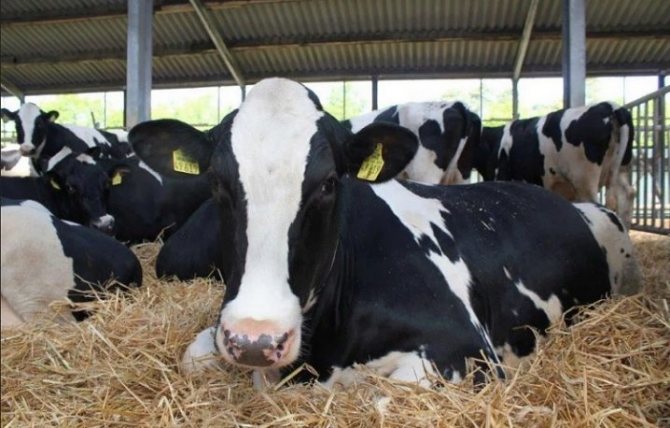

But, in addition to the obvious advantages, one should also take into account the disadvantages of this breed of cows.
- Excessive requirements for animal hygiene.
- To increase the productivity of gobies, they should be provided with high quality feed and in large quantities.
- The harsh climate negatively affects the productivity of cows. This can result in poor health and a decrease in livestock milk yield.
- The decrease in productivity is greatly influenced by a high level of sensitivity and poor stress resistance.
These characteristics can cause many difficulties in raising a Holstein cow at home.
Therefore, before purchasing such a variety of cattle, it is necessary to familiarize yourself with all the nuances of their maintenance.
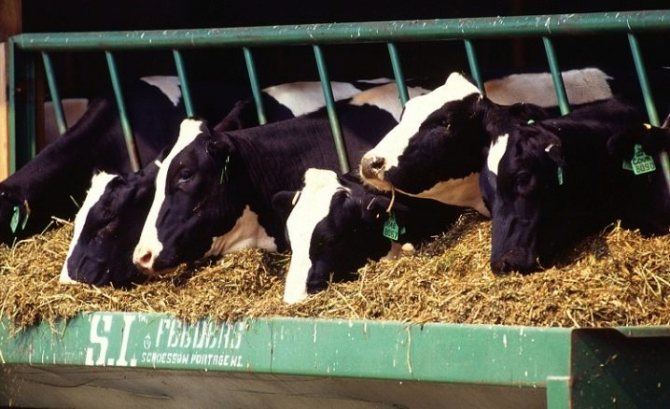

Milk productivity of cows
Milk yield is influenced by the region where the cows live, as well as climatic conditions and the diet of animals.
Israel managed to achieve the most comfortable living conditions for cattle of this breed. Farmers from one cow donate up to 10 tons of milk every year. Its fat content reaches 3.1%, and its protein content is 3%.
North American residents receive up to 9000 liters of milk annually from one cow.
The fat content of cows in the North American region is higher than that of Israelis, and is about 3.8%. In Russia, milk yields are much lower due to the severity of the climate - up to 7500 liters per year.
At the same time, the fat content of milk is characterized by good indicators, reaching 3.8%. The red-motley cow of the Holstein breed produces rather fatty milk, but in terms of quantitative indicators of milk yield it is much inferior to the black-motley counterparts.
Breeding rules
In the process of breeding the Holstein breed, in the case of gobies, breeders pay attention to the health status and characteristics of the offspring. As for the heifers, they get their assessment by comparing the quantity and performance of the products.
Cows of this breed are characterized by a high level of fertility - this is due to the fact that in the process of gestation and feeding, it does not lose its productivity... In a four-year period, a cow can produce offspring, the maximum number of which reaches 4 calves. As with many other breeds, the dry period can last anywhere from 50 to 70 days. For the health of the livestock it is necessary to determine the launch limit
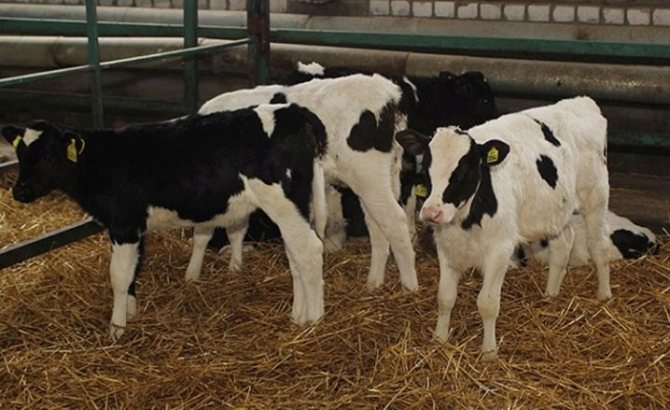

After the cow has calved, it is necessary to clean the calf from mucus. For this purpose, you can use a regular towel. At first, the offspring should be kept in a separate room, in which you need to create suitable conditions:
- lack of drafts;
- the room temperature indicator must be at least 18 degrees Celsius;
- it is recommended to place the calves on a bed made of straw, which must be changed from time to time.
For feeding, a special device is needed through which the calves can receive the mother's milk. At first, this process should be carried out at least six times a day. A portion for each calf is one liter of colostrum.
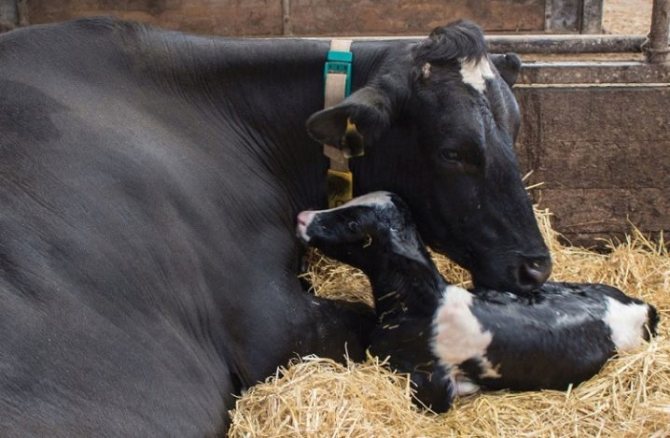

It is best to start giving milk to calves 10 days after birth. After 1 month, the ration of the offspring of livestock can be saturated with food for adult animals. It is recommended to clean the area where the calves are kept once every two weeks. The container from which the animals drink should be rinsed with slightly hot water.
It is worth emphasizing that in the process of breeding the Holstein breed of cows, only its purebred representatives need to be crossed. Otherwise, animals grow up with various kinds of deviations.
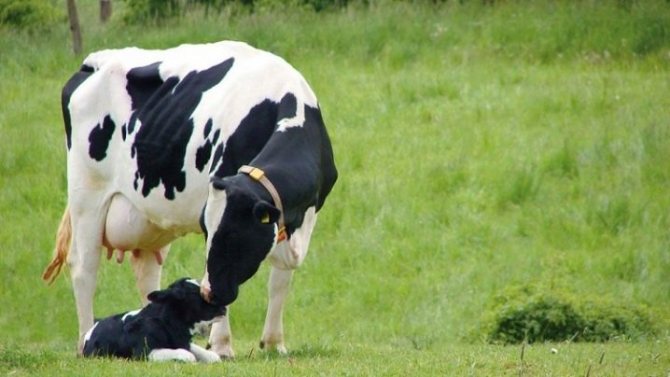

Feeding types
The main subtlety is that you cannot feed animals with the same diet throughout the year. It should take into account both the physiological changes that occur to the cow throughout her life (calving, launching, etc.), and the season.
The dry period must be at least 45 days and no more than 66 days in order for the cow to finish preparing for calving on time.
This period should be entered slowly, this is also called "launch". And the content of juicy and concentrated feed is reduced by a third. A week before the expected calving, silage and haylage are not fed, but concentrates are removed in 2-3 days.
Heifers and dry cows are fed 2-3 times a day.
The dry period or dry period is when the cow is either not milked yet (heifer), or she has stopped milking (started) before she needs to calve.
The calving animal immediately gets plenty of (and then a few more days) good wheatgrass or clover hay, vetch oats can also be used, after another couple of days, you can give out a little mixed feed. Roots and tubers are introduced into its “menu” little by little, and silage in general can be given only after the end of colostrum formation.Further feeding is done like a lactating or breastfeeding cow.
The special meaning in the feeding ration for lactating cows means linking the rations to the different stages of lactation itself. So that slowly changing, he ensured the complete satisfaction of the cows with good nutrition.
There are several such important stages in cows, at each birth of a calf: calving, milk production, lactation, and its end.
Table 2 shows the change in the proportion of different types of feed, depending on what the lactation period is. It shows changes in both the quantity and quality of the feed given. Table 3 shows the ration applicable for milk production. And table 4 shows the diet for feeding, from the middle to the end of her lactation.
Table 2. The structure of feeds of different physiological states (in% ratio)
Table 3. Milk ration (100 days after calving)
Table 4. Diet after milk (100-305 days after calving)
Care features
As mentioned earlier, Holsteins are the world record holders for annual milk yield, and their product is rich in protein and a high percentage of fat. To achieve this result, you must adhere to certain standards for keeping cattle. Obviously, if you systematically violate the basic rules of animal care, you can affect the deterioration of their effectiveness.
Before starting the cultivation and breeding of Holstein cows, it is recommended to start arranging the premises for their maintenance. The barn must be kept clean. Drafts are very bad for livestock, so it is worth getting rid of all the cracks in the room. But in such conditions, one should not forget about ventilation. There should be normal air circulation in the room. The barn should also have separate sections for cows in the form of corrals.
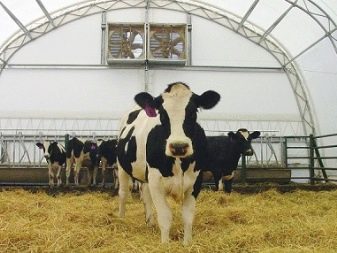

When compiling a ration, keep in mind that cows need a lot of protein. Calves at an early age eat milk at all. And for one-year-old animals, you should make a good diet, saturated with all the necessary nutrients. Feeding cows also involves the use of food ingredients such as grass and leguminous hay. Before giving the cows water, the liquid must be heated and given to the cows only in a warm state.
Another important criterion for caring for Holsteins is periodic examination by a veterinarian. Despite a very strong immune system, the animals can still be affected by the disease.
It is best to entrust the diagnosis of such diseases to a professional, as well as their treatment.
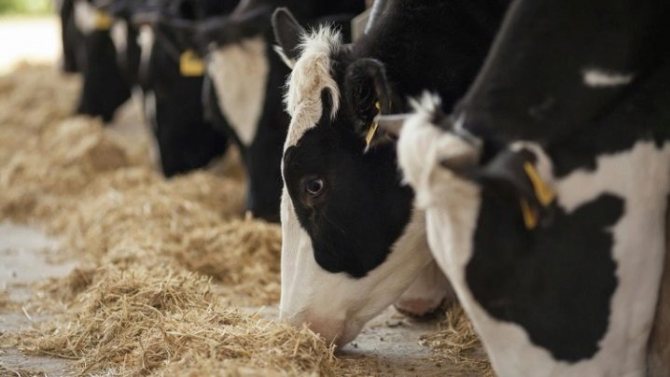

Holstein-Friesian cattle keeping
Unfortunately, simplicity is not among the advantages of the Holsteins, so they need to organize special conditions of detention. Stress has a rather negative effect on these cows, while stress should be understood as any unpleasant impact: sudden temperature changes in the barn, improper feeding, difficult pregnancy and improper milking.
During pregnancy, the cow, as a rule, gains additional weight and weighs 55-70 kg more than usual. However, any stress at this time has an even more detrimental effect on the condition of the livestock. Calving and pregnancy in these animals most often occurs without significant problems. They will additionally need care and constant supervision in the last month of pregnancy. According to statistics, 9 out of 10 cows go through calving without difficulties.
Although a Holstein cow produces 4-6 tons of milk annually, only the correct content can provide this milk yield. If you look at the reviews, it can be noted that a lot will depend on feeding. The right feed not only creates weight gain, but also increases the quality and quantity of milk. But the wrong diet will reduce milk yield and have a bad effect on health.It is not only feeding that is important, according to the description of professional livestock breeders, these cows also require proper hygiene. In order for the cow to look like in a photo from a magazine, the barn must be aired on time and cleaned regularly.
Summing up, you can identify the following breed shortcomings:
- They are demanding to feed - in winter they need grain and leguminous hay, as well as certain vitamins. In the summertime, they need to be grazed in meadows with lush and clean high quality grass.
- Poorly tolerate stress, for this reason, they lose in milk yield and weight.
- Low lethal yield with high early maturity and fertility.
- Increased requirements for cleanliness - all disease resistance is reduced to zero if the barn is not clean enough.
Diseases, their prevention and treatment
Holstein cows are the proud owners of an excellent immune system. These animals are distinguished by a high level of energy, and diseases can overtake them only in case of violation of the necessary rules of care.
Unlike many other representatives of cattle, Holsteins are considered to be very clean animals. If you ignore their hygiene or do not pay due attention to this aspect, then the risk of an infectious disease will increase.
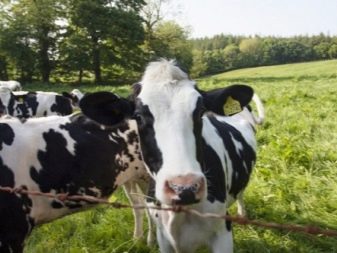

In particular, such diseases can overtake the cow.
- Necrobacteriosis... The disease is expressed by the appearance of abscesses on the limbs and udder. They can also form in the mucous membrane of the larynx of animals.
- Leptospirosis... The disease is considered to be especially dangerous for young cattle. It is characterized by a sharp rise in temperature and weight loss. Also, sick cows lose their appearance and become weak, lethargic, practically do not eat anything. Puffiness can be added to the whole "bouquet".
Cows do not tolerate drafts, and if they are present, the animal can also be exposed to a disease called mastitis. At the first signs of the disease, you should contact your veterinarian, who will be able to establish an accurate diagnosis and prescribe the correct treatment. Usually, infections in livestock are cleared of by intramuscular antibiotics.
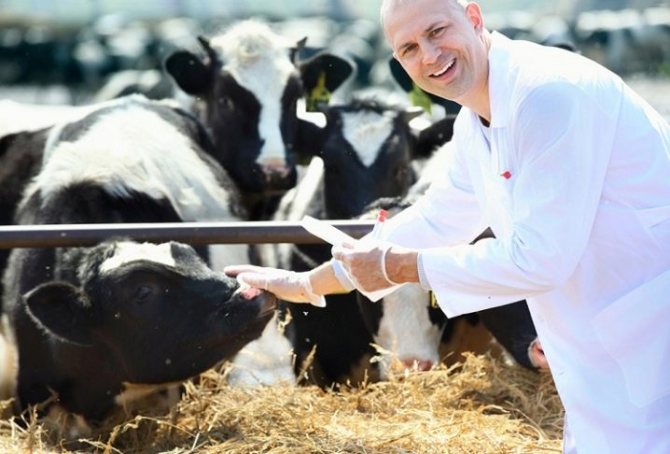

The life span of females of the Holstein breed is short. Three calving is considered the maximum for them and the cattle cannot stand more.
The next video tells about the Holstein breed of cows.
Tips and tricks for livestock breeders
If you read the forums of livestock breeders specializing in this breed on the Internet, you can find many recommendations. Most popular tips:
- for fattening, start up Holstein cows of a variegated color;
- Buy calves rather than adults to avoid the stress of a sudden change of environment;
- carefully check the barn for drafts, to which the Holstein breed is very sensitive;
- feed the animals with high quality and properly selected products, which will help to raise healthy cows.
Holstein cows are very productive but also demanding. These animals have an equal number of pluses and minuses, it is recommended to start them only by experienced livestock breeders.

